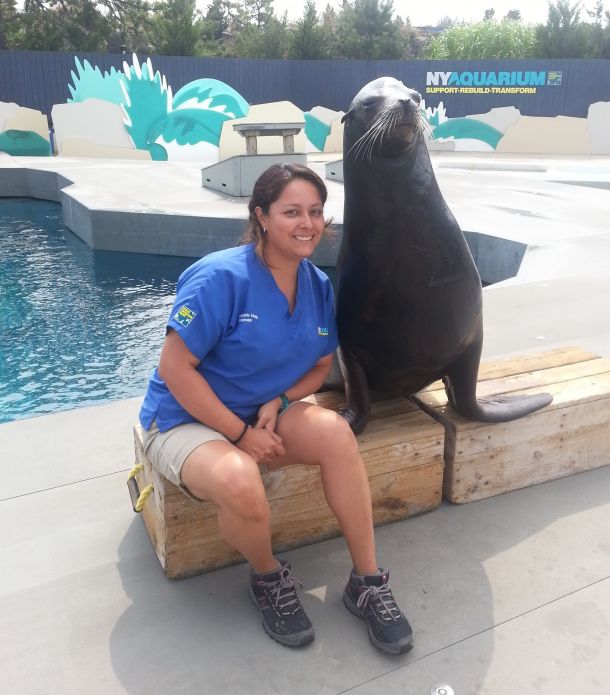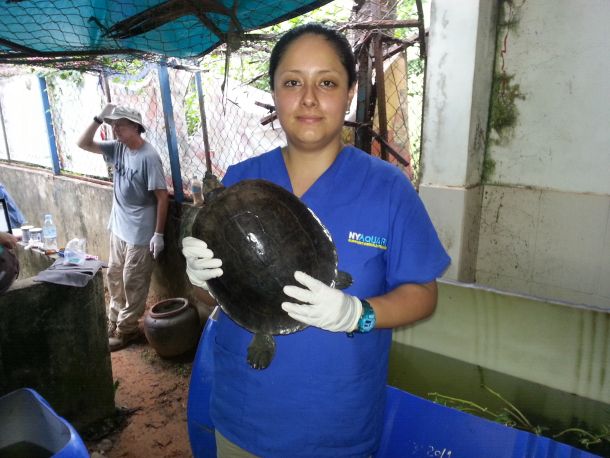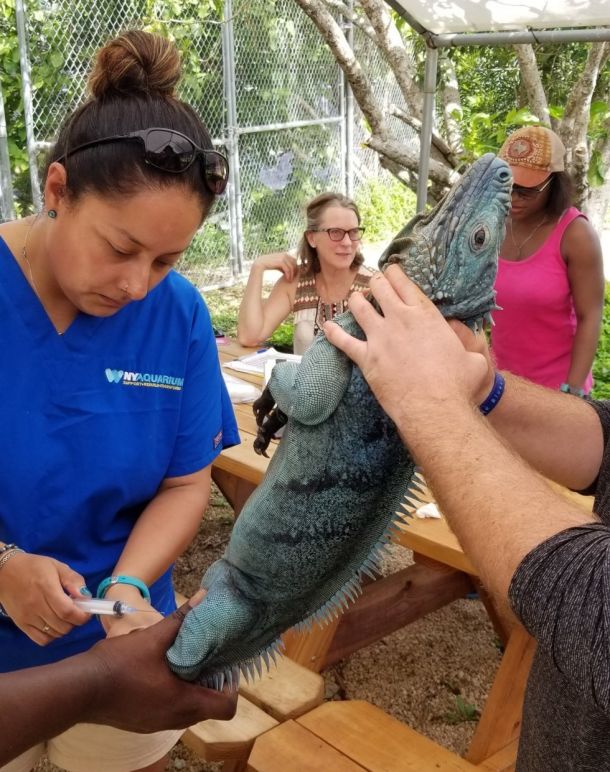This piece comes to us from the Wildlife Conservation Society (WCS). To honor Hispanic Heritage Month, WCS and Nature are bringing you stories in the fields of nature and conservation.

Bruiser the sea lion is one of the New York Aquarium’s ambassadors who promotes the importance of conservation in our oceans. Photo credit: ©WCS.
Growing up in New York, my favorite memory as a child is of my mom taking me every summer to visit the New York Aquarium and Bronx Zoo. Although I enjoyed both places, aquatic life was truly where my interest lay. I enjoyed watching the animals swimming gracefully in the water and was amazed at such unique and beautiful creatures. I carried this with me into my teens, when I decided to volunteer as a docent at the New York Aquarium.
Since my adolescence, I’ve learned what it means to be responsible and driven in order to pursue my interests. As a teen, it did not matter to me that it required an almost two-hour-long train ride to get to the aquarium and back every day. That was not an obstacle or burden for me.
As a docent, I learned more about the park’s amazing animals and the importance of conservation efforts to protect them. Many of these species have been impacted by human encroachment and habitat loss due to development. It is our responsibility to assist in preserving as much of their ecosystem as possible. I felt that I needed to help in some way, but was not sure how to do so yet.
I attended New York University, where I obtained a B.A. in biology with the idea of eventually pursuing a career in marine biology or veterinary medicine. After graduating in 2002, I volunteered in the Laboratory Services Division at the New York Aquarium doing water quality sampling and testing, which is critical in maintaining a healthy environment for aquatic species.

Health assessments of endangered southern river terrapin turtles (Batagur affinis) and their reintroduction back into the Sre Ambel River in Cambodia. Photo credit: ©WCS.
I was there only a few months when I was hired as a full-time Laboratory Technician. I also assisted the veterinary team with procedures, which really interested me. Knowing that I could contribute to maintaining the health of these incredible marine animals offered me a purpose. This led me to attend LaGuardia Community College in 2007 to get my A.A.S. in Veterinary Technology, and then obtain my license as a Veterinary Technician.
In 2009, my position at the aquarium transitioned from a Laboratory Technician to a Licensed Veterinary Technician. Since then, I have been able to progress further in my career to Senior Veterinary Technician and currently to Hospital Manager.
Working at the Wildlife Conservation Society’s New York Aquarium, where we strive to educate the public and spread the importance of conservation, makes me feel that I am helping to make a difference in our community. People of all ages who come to visit are often in awe of the amazing species they encounter. I hope they each leave with a sense of urgency to help protect all wildlife and their environment, even if it’s by something as simple as recycling or reducing personal use of plastics.

Obtaining a blood sample on an endangered blue iguana (Cyclura lewisi) in Grand Cayman as part of the health assessment process. Photo credit: ©WCS.
This single act can greatly reduce the dangerous plastics and microplastics found in our oceans, which harm and kill millions of aquatic animals each year, either through starvation, intoxication, suffocation, entanglement or drowning. Every little effort can help to make a big impact, and we should all take part and pride in it.
During my tenure at WCS I have been fortunate to participate in numerous field conservation projects, both locally and around the world. Some projects included diamondback terrapins in Queens, NY; loons in the Adirondacks; river turtles in Cambodia; blue iguanas in Grand Cayman; and a variety of sea turtles in Belize. In all these endeavors, my main role has been to assist WCS veterinarians in obtaining and processing blood samples.
Such samples provide us with critical information about how a given species is doing in the wild and—in some cases—making sure individuals are healthy before being reintroduced. I’m proud to have taken part in these conservation efforts which have made a positive contribution to each of these species’ survival in some way.

Obtaining an oral swab sample of a local terrapin species at JFK Airport as part of their health assessment. Photo credit: ©WCS.
I’m hopeful that in the future I’ll have the chance to be involved in conservation work in the Amazon or Galapagos Islands in Ecuador, where my ancestors and I are from. It would personally mean a lot to me if I could contribute to the survival of the wonderful and unique species that exist in my homeland.
You never know where life’s path might take you, but you need to take advantage of the opportunities and make the best out of all learning experiences. Reaching your goals might be a challenge, but not impossible. I was fortunate enough to end up in a career where my interests in both marine life and veterinary medicine go hand in hand, with the greater purpose of aiding conservation efforts.
I eventually found a way to help our marine wildlife as I had hoped I could all those years ago.
